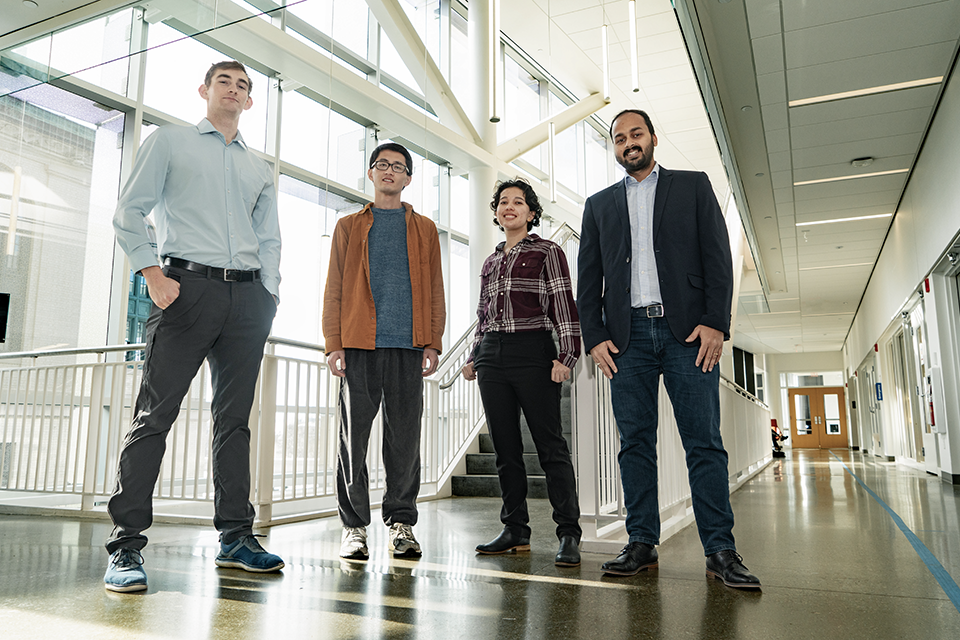
Dowd Fellowship supports “high-risk, high-reward” research
By Kaitlyn Landram
Each year, thanks to a generous gift from alumnus Philip Dowd (MSE ’63) and his wife, Marsha, the Dowd Engineering Seed Fund for Graduate Student Fellowships supports a year of doctoral expenses for multiple Ph.D. students.
The Dowd Engineering Seed Fund for Graduate Student Fellowships was created in 2001 to fund cutting-edge doctoral research in engineering at Carnegie Mellon. The research projects it supports are so new that insufficient intellectual property exists for them to be funded by government agencies and foundations, and thus must garner funding from elsewhere. Philip and Marsha Dowd established this fellowship to incubate “high-risk, high-reward” projects.
Dowd Graduate Student Fellowship recipients
The four students whose research projects were funded by the Dowd Fellowship in 2022 include:
Abhishek Anand
Development and application of low-cost techniques to determine speciated PM2.5 concentrations in Sub-Saharan Africa
Exposure to air pollution poses a severe risk to global public health. Among air pollutants, PM 2.5 (particulate matter with an aerodynamic diameter of 2.5 μm or smaller) alone is responsible for nearly 3.3 million premature deaths annually. While air quality is regulated in the United States by the Environmental Protection Agency, there is a gap in the availability of air quality information across the globe, particularly in Sub Saharan Africa (SSA) and Latin America.
Abhishek Anand, a Ph.D. student in mechanical engineering is working with Albert Presto, a research professor in mechanical engineering, to develop low-cost methods to improve air quality monitoring. Using image processing, Anand can quantify atmospheric black carbon concentrations from cell phone images of filter tapes in existing PM 2.5 monitors (beta attenuation monitors) established by US Embassies around the world. Black carbon is a component of PM 2.5 and it has shown higher health impacts than PM 2.5 alone. Anand has successfully tested the method by measuring black carbon from monitors operating at two sites in Pittsburgh, PA, and plans to further apply this method for black carbon monitoring in SSA. Anand is now developing a low-cost method to extract organic and inorganic species in PM 2.5 from the tapes, which if successful, will provide comprehensive air quality information in SSA.
Spencer Matonis
Bioresorbable drug delivery patch for localized treatment of Crohn’s disease strictures
Crohn’s Disease, an incurable autoimmune disease, is characterized by blockages in the gut made up of inflamed and fibrotic tissue, known as strictures. These strictures can lead to a multitude of problems for patients living with Crohn’s, including intestinal blockage, inability to digest and absorb food, and heightened risk of bowel perforation. Current treatment methods include injections, infusions, and oral drugs; however, these approaches are expensive, often ineffective, and can lead to unwanted side-effects.
Spencer Matonis, a materials science and engineering Ph.D. student in the research group of Chris Bettinger, a professor of materials science and engineering and biomedical engineering, is working to improve treatment for this issue through a tube-shaped structure that will be embedded at the site of the narrowing and degrade over the course of a year. This targeted treatment will allow for the controlled release of anti-inflammatory drugs directly to the symptomatic tissue.
The project is advancing to proof-of-concept testing to see how well the structure can hold itself in place and how quickly and efficiently the drugs are diffused. Methods by which to insert the system will also be evaluated. This project has been facilitated by collaborations with partners that include McGowan Institute for Regenerative Medicine, Washington University, and LifeX, a life science incubator in Pittsburgh. Matonis and his collaborators hope to eventually perform testing in human subjects through clinical trials under the supervision of the FDA.
Sandhya Ramachandran
Investigation of Neuronal Correlation at Somatosensory Cortex Induced by Transcranial Focused Ultrasound Neuromodulation
Brain disorders and diseases cost the U.S. economy more than $1.5 trillion annually. Existing pharmacological treatment is known to yield side effects, such as drug addiction, inefficiency, or overdose. Noninvasive neuromodulation has been identified as a viable alternative with limited side effects, but it is only effective if precise stimulation can be accomplished.
Sandhya Ramachandran, a biomedical engineering Ph.D. student in the research group of Bin He, professor of biomedial engineering, is working to better understand how one neuromodulation technique, low-intensity transcranial focused ultrasound or tFUS, can modulate how neurons interact with each other. tFUS uses a low-intensity ultrasound wave to stimulate the brain with high precision. It has a high spatial resolution and the ability to noninvasively target deep brain regions.
Through the support of the Dowd fellowship, the group aims to demonstrate that tFUS can be used noninvasively to modulate neural connectivity in a long lasting and parameter dependent manner. Long-term, this research may lead to future human translation of therapies that could ease the burden of neurological disorders.
Weitao Wang
A DNA nanoshell for encapsulation and protection of endothelial cells
According to the Health Resources & Services Administration, every day 17 people die waiting for an organ transplant in the US making it a public health crisis. With biomedical advancements, 3D printed organs are a reality but keeping the organs’ cells safe during the engineering process poses its own set of challenges.
Weitao Wang, a Ph.D. student in mechanical engineering, has developed a modular synthetic cell armor to protect cells during therapeutic and bioengineering applications. Working with Rebecca Taylor, associate professor of mechanical engineering, and Charlie Ren, assistant professor of biomedical engineering, Wang has encapsulated cells with a DNA origami-based nanoshell that excels in its programmability, stability, biocompatibility, and biodegradability. His finding opens new opportunities to finetune the biophysical properties of the cell membrane by exploring changes in cell behavior and function.
Pictured, top: Spencer Matonis, Weitao Wang, Sandhya Ramachandran, and Abhishek Anand